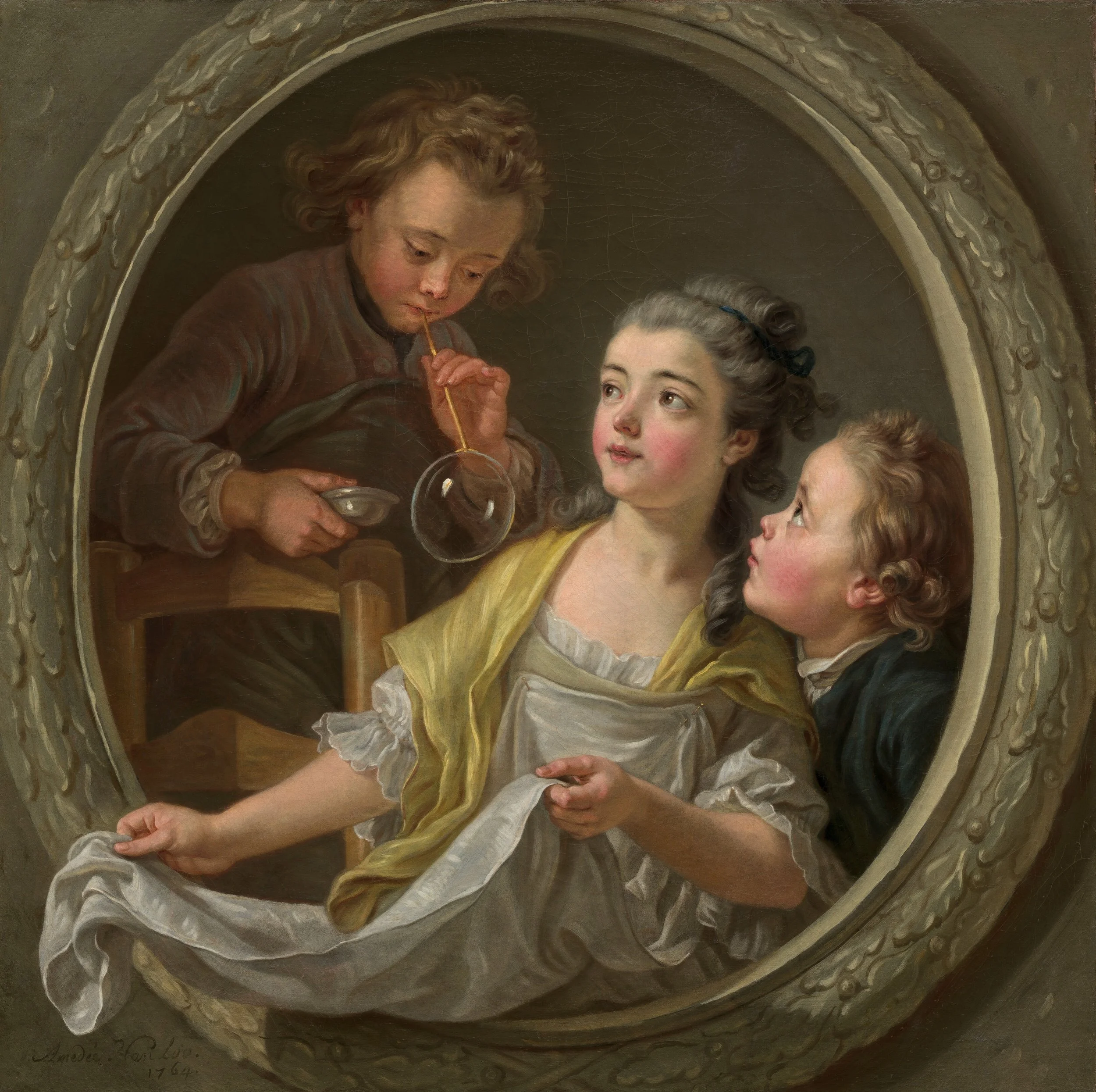Blowing soap bubbles in the 18th century
Matho. But pray let me interrupt you to aſk why the ſoap-bubbles, which boys have ſuch a pleaſure in blow-up, that they may behold the ſtrange variety of fine colours in them, are all of this ſpherical figure, whether they be great or ſmall?
Philon. Theſe bubbles, Matho, are not the diverſion of boys only, but alſo of philoſophers; and this their ſpherical figure is owing to a different cauſe.
M. To what different cauſe?
P. It is owing to the mutual repulſe between the particles of air: for this contrary affection ſerves great purpoſes in nature, and proceeds from the power of the ſame immaterial cauſe. (Matho; or, The Coſmotheoria Puerilis: A Dialogue, 1765)
Both children and adults blew bubbles in the 18th century for fun as well as to experiment with scientific principles. While clean tobacco-pipes were sometimes used for this function, many also used long, thin hollow straws, as in this description from The Young Exiles:
After the muſic lady Charlotte brought in a large bowl full of ſoap-ſuds, together with ſome ſtraw-pipes, requeſting my ſiſter to get up on a chair and blow bubbles, in order that ſhe might again behold her in the ſame attitude in which ſhe had firſt obtained admiſſion to her at Mrs Purvis’s. My ſiſter replied that ſhe was grown much older and much taller ſince that time: nevertheleſs, ſhe blew ſoap-bubbles with a ver good grace; and all the company did the ſame, not excepting even ſenhor Xavier.
The vessels used to hold the soap suds also vary considerably among the illustrations. Many use bowls, but glasses and scallop-shells also appear to have been used for this purpose.
See also 17th century bubble-blowers by Mieris, Mignard, Naiveu, and Netscher.
Memento mori by Johann Adalbert Angermayer
Cupid as an infant blowing soap bubbles
Young woman at a window blowing bubbles
Portrait presumed to be Léopold-Clément, prince of Lorraine, c. 1720
The soap bubbles by Willem van Mieris the younger
The Laundress by Chardin, 1730s
Air by Nicolas Lancret, 1730-1732
Soap Bubbles by Chardin, probably 1733/1734
Soap Bubbles by Chardin, c. 1739
Soap Bubbles by Chardin, after 1739
Blowing bubbles by Christian Wilhelm Ernst Dietrich, 1740
A lacemaker with a boy blowing bubbles by Louis de Moni, 1742
Blowing soap bubbles, a figure sketch made in Edinburgh and the neighborhood after the rebellion of 1745, by Paul Sandby
Beata Sparre by Gustaf Lundberg, 1747
A young boy blowing bubbles through a straw from a bowl of soapy water
Detail from a tea set, 1753
The little bubble-blower, 1758
A cherub next to Peter Anton Maüssner, German merchant from Nuremburg
Blowing Bubbles by Philip Mercier
A Country Life, c. 1760s
Le Petit Physicien, 1761
Soap Bubbles by Charles Amédée Philippe Van Loo, 1764
L’Observateur Distrait, 1766
Le Jeune Eplucheur, c. 1766
Vermehrung der Erfahrenheit durch den Trieb, from Elementarwerke für die Jugend und ihre Freunde, illustration by Daniel Chodowiecki, 1770
A young couple making soap bubbles by Louis de Moni
Beata Sparre by Gustaf Lundberg, 1775
Portrait of a family by Balthazar Beschey
Montgolfier in the Clouds: Constructing of Air Balloons for the Grand Monarque, 1785
Girl blowing bubbles by Gustaf Lundberg
The New Peerage or Fountain of Honor, 1787
The bubbles of opposition by James Gillray, 1788
Children blowing bubbles by Jean-Etienne Liotard
Information des Journées du 5 et 6 Octobre 1789: La voilà donc enfin ce secret plain d’horreur, 1789
Illustration of a boy blowing soap bubbles from History of British Birds
The Swallow Packet, 1792
A Member of the French War Department Raising Forses to Conquer all the World, 1793
The soap-bubbles by Jean-Jacques de Boisseu, 1799
Het meest, ô Jeugdt! dat gy hier ziet, Is Kinderſpel
Three boys playing with soap bubbles by Jean-Baptiste-Jacques Augustin
© The Trustees of the British Museum. Shared under a Creative Commons Attribution-NonCommercial-ShareAlike 4.0 International (CC BY-NC-SA 4.0) licence.
Jean-Baptiste-Siméon Chardin: The Washerwoman, Nationalmuseum
© The Trustees of the British Museum. Shared under a Creative Commons Attribution-NonCommercial-ShareAlike 4.0 International (CC BY-NC-SA 4.0) licence.



